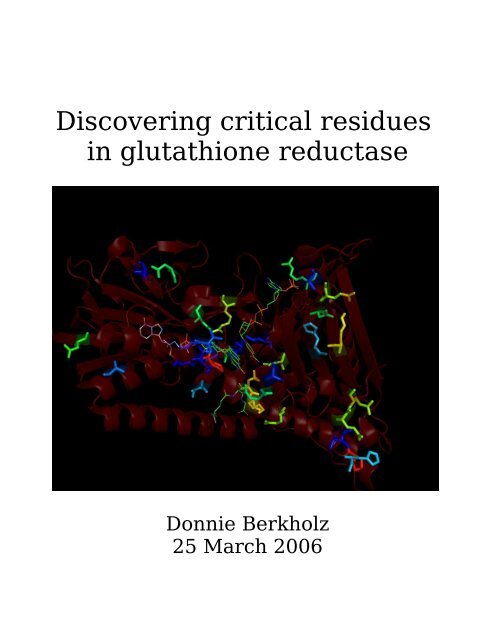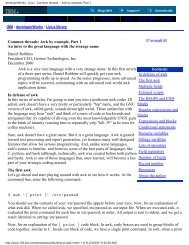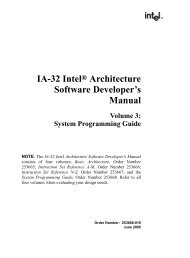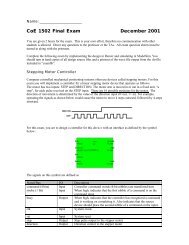Discovering critical residues in glutathione reductase - Gentoo
Discovering critical residues in glutathione reductase - Gentoo
Discovering critical residues in glutathione reductase - Gentoo
Create successful ePaper yourself
Turn your PDF publications into a flip-book with our unique Google optimized e-Paper software.
<strong>Discover<strong>in</strong>g</strong> <strong>critical</strong> <strong>residues</strong><br />
<strong>in</strong> <strong>glutathione</strong> <strong>reductase</strong><br />
Donnie Berkholz<br />
25 March 2006
Introduction<br />
Glutathione <strong>reductase</strong> (GR) is a ubiquitous enzyme that catalyzes the<br />
reduction of di<strong>glutathione</strong> (GSSG) to two reduced <strong>glutathione</strong> molecules (GSH)<br />
with the concomitant oxidation of NADPH. It does so via FAD and a disulfide<br />
l<strong>in</strong>kage with<strong>in</strong> the prote<strong>in</strong>.<br />
GR plays many important roles because of the importance of reduc<strong>in</strong>g<br />
equivalents. It ma<strong>in</strong>ta<strong>in</strong>s the level of reduced thiols <strong>in</strong> the cell, because<br />
<strong>glutathione</strong> can also reduce the other primary cellular thiol, thioredox<strong>in</strong>. GR is<br />
<strong>critical</strong> <strong>in</strong> prevent<strong>in</strong>g high levels of oxidative stress because its activity can<br />
counteract oxidation. Glutathione <strong>reductase</strong> also is important <strong>in</strong> synthesis of<br />
DNA precursors as well as proton transport across membranes.<br />
Glutathione <strong>reductase</strong> has been suggested as a potential drug target <strong>in</strong><br />
malaria because the primary malarial target <strong>in</strong> humans is the red blood cell<br />
(erythrocyte) [1]. In RBCs, 10% of produced glucose goes toward NADPH<br />
production for <strong>glutathione</strong> <strong>reductase</strong>, so it is clearly a <strong>critical</strong> enzyme there. GR's<br />
importance <strong>in</strong> reduc<strong>in</strong>g oxidative stress suggests that if the GR <strong>in</strong> Plasmodium<br />
falciparum could be disabled while the human GR reta<strong>in</strong>ed activity, it would<br />
strongly impact the effect of malaria.<br />
Much of the reaction mechanism has already been proposed [2][3], but it<br />
has not yet been proven. Crystal structures of dead-end <strong>in</strong>termediates and nonreactive<br />
prote<strong>in</strong>s illustrated potentially important <strong>residues</strong>. But as the entire<br />
reaction pathway has not been tracked experimentally, all the <strong>residues</strong> <strong>in</strong>volved<br />
can only be conjecture based on their proximity and likely reactivity.
To understand possible changes <strong>in</strong> GR's mechanism, one must first<br />
comprehend our current knowledge of the mechanism. GR operates <strong>in</strong> a p<strong>in</strong>gpong<br />
fashion, mean<strong>in</strong>g the NADPH b<strong>in</strong>ds and transfers a hydride to FAD, then<br />
leaves, before the di<strong>glutathione</strong> ever b<strong>in</strong>ds. In other words, the two substrates<br />
are mutually exclusive.<br />
Tyr197 forms a protective shield over FAD to keep it from be<strong>in</strong>g oxidized<br />
when NADPH is not bound, then sw<strong>in</strong>gs out of the way when NADPH b<strong>in</strong>ds and<br />
forms a strong hydrogen bond with Thr369. Arg291 and Asp331 form another ion<br />
pair near FAD. In three separate cases, ion pairs exist near the flav<strong>in</strong> with the<br />
positive <strong>residues</strong> of the pair po<strong>in</strong>ted at the flav<strong>in</strong>.<br />
Other <strong>residues</strong> known important <strong>in</strong> b<strong>in</strong>d<strong>in</strong>g of the NADPH phosphate<br />
<strong>in</strong>clude Arg218, Arg224, His219 and some <strong>in</strong>tegral waters. The nicot<strong>in</strong>amide r<strong>in</strong>g<br />
is where the hydride is transferred to FAD, and there are a number of <strong>residues</strong><br />
suspected to be <strong>critical</strong> there. Residues <strong>in</strong>volved <strong>in</strong> b<strong>in</strong>d<strong>in</strong>g the nicot<strong>in</strong>amide<br />
<strong>in</strong>clude Leu337, Glu201, Lys66, Val370 and Thr369. Glu201 and Lys66 also form<br />
a salt bridge.<br />
In <strong>glutathione</strong> b<strong>in</strong>d<strong>in</strong>g, <strong>residues</strong> directly hydrogen bond<strong>in</strong>g to <strong>glutathione</strong><br />
<strong>in</strong>clude side cha<strong>in</strong>s of Ser30, Arg37, Tyr114, Arg347, His467' and Glu473' as well<br />
as ma<strong>in</strong> cha<strong>in</strong> atoms of Met406' and Thr469'. Tyr114 moves about 1A on GSSG<br />
b<strong>in</strong>d<strong>in</strong>g and fits well between the glyc<strong>in</strong>e moieties of the two <strong>glutathione</strong>s. It's<br />
well positioned to be a proton donor for a leav<strong>in</strong>g <strong>glutathione</strong>, but unlikely<br />
because of its normally high pKa. It could be <strong>in</strong>terest<strong>in</strong>g to exam<strong>in</strong>e whether any<br />
nearby conserved <strong>residues</strong> could modify its pKa. Through-water hydrogen bonds<br />
occur with the side cha<strong>in</strong>s of Lys67, Tyr106, Asn117, Ser470', Glu472' and
Thr476' and the ma<strong>in</strong> cha<strong>in</strong> of Gly55, Pro468' and Thr476'.<br />
The first step of the reaction is the NADPH-dependent reduction of FAD.<br />
Tyr197 may also play a role here, act<strong>in</strong>g as a “spr<strong>in</strong>g” to force the nicot<strong>in</strong>amide<br />
r<strong>in</strong>g closer to the FAD to ease hydride transfer. In addition, the Lys66-Glu201<br />
salt bridge is near where the hydride transfer occurs.<br />
Next, the flav<strong>in</strong> reduces the disulfide Cys58-Cys63, likely through an<br />
<strong>in</strong>termediary adduct with the sulfur of Cys63. Few important <strong>residues</strong> have been<br />
proposed <strong>in</strong> this step of catalysis.<br />
F<strong>in</strong>ally, the reduced, former disulfide reduces GSSG and is reoxidized to<br />
the disulfide. Cys63, His467' and Glu472' have been proposed to act similarly to<br />
the catalytic triad <strong>in</strong> ser<strong>in</strong>e proteases – glutamate activates the histid<strong>in</strong>e, which<br />
<strong>in</strong> turn creates a highly nucleophilic cyste<strong>in</strong>e. The importance of His467' as a<br />
proton acceptor and donor has also been shown via mutagenesis. But aga<strong>in</strong>,<br />
while the <strong>residues</strong> most active <strong>in</strong> catalysis have been proposed, not all of the<br />
<strong>critical</strong> <strong>residues</strong> that enable catalysis <strong>in</strong> the region have been elucidated.<br />
A bio<strong>in</strong>formatic approach to f<strong>in</strong>d<strong>in</strong>g important <strong>residues</strong> <strong>in</strong> <strong>glutathione</strong><br />
<strong>reductase</strong> could allow detection of what must be <strong>critical</strong> to its activity or<br />
structure. Us<strong>in</strong>g a comb<strong>in</strong>ation of multiple sequence alignments, phylogenetic<br />
trees, and tree-based calculation of conserved <strong>residues</strong>, the goal of this project is<br />
to decipher what <strong>residues</strong> really are <strong>critical</strong> <strong>in</strong> GR and propose roles for them.<br />
This will comb<strong>in</strong>e check<strong>in</strong>g for am<strong>in</strong>o acids previously thought vital to b<strong>in</strong>d<strong>in</strong>g<br />
and catalysis as well as a rational search for other, unknown conserved <strong>residues</strong>.<br />
In addition, a short survey of available methods and program implementations<br />
for accomplish<strong>in</strong>g this goal will be made to discern which methods work the best.
Materials and Methods<br />
Multiple sequence alignments<br />
ClustalW [4] is a progressive, global multiple sequence alignment program.<br />
It performs all possible pairwise alignments, uses those to create a neighborjo<strong>in</strong><strong>in</strong>g<br />
phylogenetic tree, and aligns the sequences us<strong>in</strong>g dynamic programm<strong>in</strong>g<br />
based on the tree. The most closely related sequences are aligned first, and more<br />
and more distant sequences are added on.<br />
T-Coffee [5] is a more complex global MSA program that beg<strong>in</strong>s with<br />
ClustalW output and a set of pairwise local alignments from LALIGN, then<br />
creates a set of weights from those to produce a progressive MSA. The primary<br />
downside is that T-Coffee generally takes more than 10 times longer to run than<br />
most other MSA programs.<br />
Dialign-T [6] is a local alignment program that excludes poorly match<strong>in</strong>g<br />
subfragments and adds sequences to the alignment based on their weight scores<br />
<strong>in</strong> a way that removes bias from highly similar pairs.<br />
Muscle [7] is another global MSA program that makes use of a “logexpectation”<br />
score and aga<strong>in</strong>, a phylogenetic tree, to partition sequences <strong>in</strong> a<br />
tree-based manner.<br />
ProbCons [8] is based on a new model of alignment called probabilistic<br />
consistency. It uses pairwise HMM-based alignments, but it does them with<br />
three-way consistency. That means that if sequence A and B align well, and B<br />
and C align well, then A and C must align well. In addition, rather than us<strong>in</strong>g a<br />
typical arbitrary substitution matrix as most alignment programs do, it tra<strong>in</strong>s<br />
itself on available sequence databases to create an experimentally supported
matrix. It performs roughly 7% better than T-Coffee <strong>in</strong> f<strong>in</strong>d<strong>in</strong>g 100% sequence<br />
identity at a given position, 11% better than ClustalW and 14% better than the<br />
local alignment program Dialign.<br />
Phylogenetic trees<br />
ProML from the PHYLIP [9] package was used to calculate maximum<br />
likelihood trees. However, us<strong>in</strong>g the best models available and an am<strong>in</strong>o acid<br />
sequence rather than a DNA sequence resulted <strong>in</strong> extensive computational time.<br />
MrBayes [10] was used to calculate Bayesian trees. MrBayes operates<br />
us<strong>in</strong>g a Markov cha<strong>in</strong> Monte Carlo method, which uses a hidden Markov modelbased<br />
random search of the available tree space. The method has a true basis <strong>in</strong><br />
statistics and results <strong>in</strong> probability-based trees; this precludes the need for<br />
bootstrapp<strong>in</strong>g.<br />
In both programs, the distribution model of rates was a gamma distribution<br />
with additional <strong>in</strong>variant sites. In ProML, the gamma distribution was<br />
approximated with 5 separate rate categories. In MrBayes, 6 rate categories<br />
were used.<br />
Conservation of <strong>residues</strong><br />
ConSurf [11] was used to evaluation evolutionarily-based residue<br />
conservation. Version 3.0 was chosen because it implements a Bayesian method,<br />
which was shown to be superior to the older maximum likelihood method for<br />
smaller numbers of sequences.
Figure 1: Alignment of Arg218. From left to right, ClustaW, Dialign-T, Muscle and<br />
ProbCons. Conservation values are below. See text for discussion.<br />
Results and Discussion<br />
To discover the best multiple sequence alignment program for this project,<br />
a survey of the literature was made us<strong>in</strong>g Google Scholar. The search focused on<br />
global alignment methods because the <strong>glutathione</strong> <strong>reductase</strong> sequences <strong>in</strong> the<br />
alignment were similar through their entire lengths, rather than just hav<strong>in</strong>g<br />
small doma<strong>in</strong>s of similarity. However, one local alignment method, Dialign-T, was<br />
<strong>in</strong>cluded because reviews showed it compar<strong>in</strong>g favorably with both local and<br />
global alignment programs when used aga<strong>in</strong>st databases. The compared<br />
programs were ClustalW, Dialign-T, T-Coffee, Muscle and ProbCons.<br />
Out of all the programs, only ProbCons managed to f<strong>in</strong>d a 100% conserved
arg<strong>in</strong><strong>in</strong>e at position 218. All of the other programs failed to align their gaps<br />
correctly rather than not hav<strong>in</strong>g gaps at all, <strong>in</strong>dicat<strong>in</strong>g that this could not be<br />
fixed by tweak<strong>in</strong>g gap penalties or gap extension penalties. In JalView, the<br />
ProbCons alignment shows clearly higher alignment scores throughout the entire<br />
region (Figure 1).<br />
Figure 2: Cladistic credibility values of the Bayesian mixed-model tree. See<br />
text for discussion.<br />
To discover the best fixed-rate am<strong>in</strong>o acid substitution matrix for these
sequences, a convenient feature of MrBayes was used called the mixed model.<br />
This model samples from all the available matrices, and the amount of time spent<br />
us<strong>in</strong>g each matrix <strong>in</strong>dicates the probability of that matrix be<strong>in</strong>g the best fit for<br />
the data. This is computationally much cheaper than optimiz<strong>in</strong>g all the variables<br />
<strong>in</strong> even a fairly simple variable-rate model. Variable-rate models were also<br />
attempted, but they were too computationally expensive. Even a simple variablerate<br />
model with only 19 free variables failed to converge after a solid week of<br />
comput<strong>in</strong>g. Over the course of 100,000 cycles, MrBayes spent nearly 100% of its<br />
time us<strong>in</strong>g the WAG matrix, <strong>in</strong>dicat<strong>in</strong>g its superiority over the typically used JTT<br />
matrix for the GR sequences. The WAG matrix was created us<strong>in</strong>g phylogenetic<br />
<strong>in</strong>ference and maximum likelihood aga<strong>in</strong>st large databases and is <strong>in</strong>tended<br />
primarily for globular prote<strong>in</strong>s, which GR approximates.<br />
Figure 3: The environment of NADPH. See text for discussion.<br />
The result<strong>in</strong>g tree showed strong support for roughly the expected results,
with one exception (Figure 2). There was about 90-100% support for the entire<br />
tree except for placement of the plants with<strong>in</strong> the tree, which only had about 65-<br />
70% support. Other than that, as expected, animals split out from plants, and<br />
both of them split apart from prokaryotes. No further analysis of the tree itself<br />
will be made, because it was <strong>in</strong>tended as an <strong>in</strong>termediate for <strong>in</strong>put <strong>in</strong>to further<br />
programs.<br />
ConSurf is a program to calculate evolutionarily conserved <strong>residues</strong> and<br />
map them onto a prote<strong>in</strong> structure. The true power of it is <strong>in</strong> its flexibility – it will<br />
take a list of sequences and a PDB ID as <strong>in</strong>put, or you can <strong>in</strong>put a precalculated<br />
sequence alignment, or even a precalculated phylogenetic tree, along with your<br />
own PDB. This allows for potential creation of better structural conservation<br />
maps, because ConSurf just uses ClustalW for alignment and a simple neighborjo<strong>in</strong><strong>in</strong>g<br />
tree. ConSurf outputs a large table of conservation values, and optionally<br />
replaces the B factors <strong>in</strong> the PDB file with conservation values, so any molecular<br />
graphics program can be used for the analysis. However, ConSurf does not yet<br />
allow delv<strong>in</strong>g <strong>in</strong>to tree-determ<strong>in</strong>ant <strong>residues</strong>. In other words, no simple way<br />
exists to analyze changes on smaller level than the entire tree to exam<strong>in</strong>e<br />
changes <strong>in</strong> function between different Grs.
Figure 4: Ile26 <strong>in</strong> FAD b<strong>in</strong>d<strong>in</strong>g. See text for discussion.<br />
Initial analysis focused on the active site, where there is already a long list<br />
of <strong>residues</strong> suspected important <strong>in</strong> b<strong>in</strong>d<strong>in</strong>g and catalysis. Near the NADPH<br />
(Figure 3), one can see that many of the expected <strong>residues</strong> were conserved:<br />
Arg291, Glu201, and others. But there are more conserved <strong>residues</strong>: Ser177,<br />
Asp178, Gln445, and <strong>in</strong>terest<strong>in</strong>gly, Ile198. Ser177 appears to hydrogen bond<br />
with the nicot<strong>in</strong>amide r<strong>in</strong>g, which may serve to orient it correctly for hydride<br />
transfer. It's already known that generally the positive residue of ion pairs is<br />
nearer to the flav<strong>in</strong>, but what grows more clear here is that there are conserved<br />
positive <strong>residues</strong> above the flav<strong>in</strong> (Gln445 and Arg291 on the NADPH side), and<br />
the conserved negative Asp178 below the flav<strong>in</strong>. This negative charge just below<br />
the carbon that accepts a hydride from NADPH may serve some purpose <strong>in</strong>
assist<strong>in</strong>g with reduction of the Cys58-Cys63 disulfide.<br />
Figure 5: Arg218 b<strong>in</strong>ds the phosphate of NADPH. See text for discussion.<br />
Ile198 could be <strong>in</strong>volved <strong>in</strong> hydrophobic b<strong>in</strong>d<strong>in</strong>g of NADPH, as it po<strong>in</strong>ts<br />
toward the nicot<strong>in</strong>amide r<strong>in</strong>g. It's also <strong>in</strong> the environment of the Lys66-Glu201<br />
salt bridge, so it could serve to lower the local dielectric constant and strengthen<br />
the <strong>in</strong>teractions of the salt bridge with the nicot<strong>in</strong>amide and flav<strong>in</strong>. In a similar<br />
way as Ile198 may b<strong>in</strong>d NADPH, Ile26 appears <strong>in</strong>volved <strong>in</strong> hydrophobic b<strong>in</strong>d<strong>in</strong>g<br />
of the aden<strong>in</strong>e moiety of FAD (Figure 4). It's about 3.8A away from the r<strong>in</strong>g and<br />
may stabilize b<strong>in</strong>d<strong>in</strong>g.
Figure 6: The Cys58-Cys63 disulfide environment. See text for discussion.<br />
The phosphate of NADPH must be stabilized <strong>in</strong> some way, but previous<br />
analysis revealed no nearby positively charged <strong>residues</strong>. They hypothesized that<br />
it was stabilized via hydrogen bonds with waters. The present analysis reveals<br />
Arg218 with its backbone nitrogen only 4A from an oxygen of the phosphate and<br />
its sidecha<strong>in</strong> about 4.3A from the aden<strong>in</strong>e moiety of NADPH (Figure 5).<br />
Many <strong>residues</strong> are conserved near the Cys58-Cys63 disulfide loop,<br />
<strong>in</strong>clud<strong>in</strong>g Ser30 and Thr339 (Figure 6). The threon<strong>in</strong>e is only 3.5A from the<br />
sulfur of Cys63, but its role is unclear. It may serve to stabilize a charged<br />
reaction <strong>in</strong>termediate with a hydrogen bond. Ser30 is a bit farther away from<br />
Cys58, 4.6A, but it could serve a similar purpose with a small conformational<br />
change, as would happen when the disulfide bond is reduced.
Figure 7: Catalytic <strong>residues</strong> His467' and Glu472'. See text for discussion<br />
The catalytic His467' and Glu472' are on the opposite end of the prote<strong>in</strong><br />
from the active site, because they participate <strong>in</strong> the active site of the other<br />
dimer. One can see that the carboxyl group of Glu472' is about 3A from the<br />
imidazole r<strong>in</strong>g of histid<strong>in</strong>e, with one oxygen at 2.8A and another at 3.2A (Figure<br />
7). Also, Pro468' is highly conserved because it allows for one of the two cis<br />
peptide bonds <strong>in</strong> the prote<strong>in</strong>, which is required for the correct conformation of<br />
histid<strong>in</strong>e and glutamate. Thr469' and Glu473' are conserved as well, but their<br />
roles are unclear without analysis of the entire dimer with them <strong>in</strong> the active<br />
site. Their negative charges could keep Glu472' near the histid<strong>in</strong>e r<strong>in</strong>g so it's<br />
always able to polarize the imidazole.
Figure 8: Phe254, a surface hydrophobic residue. See text for discussion.<br />
Mov<strong>in</strong>g away from <strong>residues</strong> <strong>in</strong>volved <strong>in</strong> the active site, one can exam<strong>in</strong>e<br />
where hydrophobic conserved <strong>residues</strong> fall with<strong>in</strong> the prote<strong>in</strong>. As Kendrew's<br />
rules say, (1) Hydrophilic <strong>residues</strong> are on the surface, (2) Hydrophobic <strong>residues</strong><br />
are <strong>in</strong> the core, and (3) Any violation of the above rules <strong>in</strong>dicates function.<br />
Follow<strong>in</strong>g this, there is an odd occurrence of a 100% conserved hydrophobic<br />
residue on the surface of the prote<strong>in</strong> away from the active site, Phe354 (Figure<br />
8). As this is grossly energetically unfavorable, it must serve some purpose,<br />
although what purpose exactly rema<strong>in</strong>s unclear. If one looks at nearby nonhydrophobic<br />
conserved <strong>residues</strong>, one f<strong>in</strong>ds Ala39 and Asp22, both about 4-5A<br />
from the phenylalan<strong>in</strong>e r<strong>in</strong>g. This suggests some sort of b<strong>in</strong>d<strong>in</strong>g site for an<br />
<strong>in</strong>hibitor or activator, because no structural stability is possible from it, and the
active site is quite far away.<br />
Figure 9: Conserved hydrophilic surface <strong>residues</strong> near the NADPH b<strong>in</strong>d<strong>in</strong>g site<br />
entrance. See text for discussion.<br />
Another, more typical occurrence of surface conserved <strong>residues</strong> is Asp316,<br />
Thr321 and Asp22 (Figure 9). Asp316 and the threon<strong>in</strong>e are 6.6A apart,<br />
preclud<strong>in</strong>g a direct <strong>in</strong>teraction. Asp22 is roughly 15A away from both of them.<br />
They fall near where NADPH should enter its b<strong>in</strong>d<strong>in</strong>g site, so they may serve as<br />
some sort of gatekeepers or ma<strong>in</strong>ta<strong>in</strong> the structure of the b<strong>in</strong>d<strong>in</strong>g site's entrance.
Figure 10: Structural stabilization. See text for discussion.<br />
The f<strong>in</strong>al group of conserved <strong>residues</strong> <strong>in</strong> this analysis falls at a junction of<br />
beta sheets and an alpha helix (Figure 10). Positively charged His434 and<br />
Lys420 extend out from the beta sheets toward the helix's Asp227 and Glu384<br />
from the nearby loop. These 100% conserved, balanced charges suggest some<br />
ga<strong>in</strong> <strong>in</strong> structural stability. It may be that this particular part of the structure,<br />
while nowhere near the active site, must be reta<strong>in</strong>ed or some sort of allosteric<br />
effect could reach <strong>in</strong>to the active site and dramatically affect b<strong>in</strong>d<strong>in</strong>g or<br />
catalysis. Another possibility is that these <strong>residues</strong> are <strong>critical</strong> <strong>in</strong> GR's fold<strong>in</strong>g<br />
process.<br />
In conclusion, this study has used bio<strong>in</strong>formatics as a tool <strong>in</strong> analysis of<br />
structure-function relationships. Rema<strong>in</strong><strong>in</strong>g work <strong>in</strong>cludes check<strong>in</strong>g whether the
model used for tree-build<strong>in</strong>g was valid, expand<strong>in</strong>g this study to all known GR<br />
sequences, creat<strong>in</strong>g more experimental enzymology data, and analyz<strong>in</strong>g treedeterm<strong>in</strong>ant<br />
<strong>residues</strong>. It found new <strong>critical</strong> <strong>residues</strong> and proposed functions for<br />
some of them, while functions for others rema<strong>in</strong> to discern. It confirmed the<br />
importance of many catalytic <strong>residues</strong>. It determ<strong>in</strong>ed the best alignment program<br />
to use with this set of sequences, as well as the best am<strong>in</strong>o acid substitution<br />
matrix for use <strong>in</strong> creat<strong>in</strong>g phylogenetic trees.<br />
References<br />
Sarma, G.N., Savvides, S.N., Becker, K., Schirmer, M., Schirmer, R.H. and Karplus, P.A. Glutathione<br />
<strong>reductase</strong> of the malarial parasite Plasmodium falciparum: Crystal structure and <strong>in</strong>hibitor development.<br />
2003.<br />
Pai., E.F. and Schulz, G.E. The catalytic mechanism of <strong>glutathione</strong> <strong>reductase</strong> as derived from X-ray<br />
diffraction analyses of reaction <strong>in</strong>termediates. 1983.<br />
Karplus, P.A., and Schulz, G.E. Substrate b<strong>in</strong>d<strong>in</strong>g and catalysis <strong>in</strong> <strong>glutathione</strong> <strong>reductase</strong> as derived from<br />
ref<strong>in</strong>ed enzyme: Substrate crystal structures at 2A resolution. 1989.<br />
Chenna, R., Sugawara, H, Koike, T., Lopez, R., Gibson, T.J., Higg<strong>in</strong>s, D.G. and Thompson, J.D. Multiple<br />
sequence alignment with the Clustal series of programs. 2003.<br />
Notredame, C., Higg<strong>in</strong>s, D., and Her<strong>in</strong>ga, J. T-COFFEE: A novel method for multiple sequence<br />
alignments. 2000.<br />
Subramanian, A.R., Weyer-Menkhoff, J., Kaufmann, M., and Morgenstern, B. DIALIGN-T: An<br />
improved algorithm for segment-based multiple sequence alignment. 2005.<br />
Edgar, R.C. MUSCLE: Multiple sequence alignment with high accuracy and high throughput. 2004.<br />
Do, C.B., Mahabhashyam, M.S.P., Brudno, M., and Batzoglou, S. ProbCons: Probabilistic consistencybased<br />
multiple sequence alignments. 2005.<br />
Felsenste<strong>in</strong>, J. PHYLIP - Phylogeny Inference Package (Version 3.2). 1989.<br />
Ronquist, F. and Huelsenbeck, J.P. MRBAYES 3: Bayesian phylogenetic <strong>in</strong>ference under mixed models.<br />
2003.<br />
Landau, M., Mayrose, I., Rosenberg, Y., Glaser, F., Martz, E., Pupko, T., and Ben-Tal, N. ConSurf:<br />
Identification of functional regions <strong>in</strong> prote<strong>in</strong>s by surface-mapp<strong>in</strong>g of phylogenetic <strong>in</strong>formation. 2005.
















